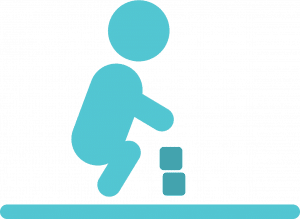Child development is the process by which the dependent infant matures into the independent adult, functioning within society. It is a complex interweaving of biology, psychology and environment where each skill builds on the ones that have come before and provides a foundation for those skills yet to develop.
Development in humans follows a predictable pattern and a rough schedule but no individual develops in exactly the same manner as any other. It follows an orderly pattern (unlike almost everything else regarding children); from top to bottom, central to outer and simple to complex. What is important, when considering normal development, is progress and parity; that children are moving forward in the different areas of development at roughly the same rate.
Disparity in progress between areas of the body (e.g. the right side and the left or the lower limbs and the upper limbs) or between domains of development (see below) is concerning, as is regression (i.e. loss of previously attained skills).
This article will outline the typical stages of development that children go through. The features typically seen at each age are described below.
Fine motor development
Fine motor development refers to the smaller movements, mostly concentrated in the hands, such as grip, manipulation of small objects, writing and using scissors. This area of development is important as these skills underpin many others; if you can’t hold and manipulate objects because there’s a problem with the muscles of your hands (fine motor skill), you won’t be able to feed yourself using a fork or spoon (social skill).
| Age | Feature |
| 1 month | Grasps a finger when placed in the palm |
| 3 months | Watches their own hands
Brings hands to their mouth Holds a toy briefly |
| 6 months | Palmar grasp
Reaches for toys Puts objects into mouth
|
| 9 months | Passes toys from one hand to the other
May have a pincer grip |
| 12 months | Fine pincer grip
Points to objects of interest Releases objects intentionally
|
| 15 months | Imitates to and fro scribbles
Builds a tower of 2 cubes, when demonstrated
|
| 18 months | Makes a tower of 3 blocks
|
| 24 months (2 years) | Builds a tower of 6 blocks
Draws a horizontal line with preferred hand, may draw vertical lines Turns pages of a book individually
|
| 30 months | Can thread beads on a string
Makes a tower of 7 or more blocks Holds a pencil with a tripod grip |
| 36 months (3 years) | Builds a bridge using blocks
Draws a circle Draws a person with a head
|
| 42 months (3.5 years) | Draws a cross
|
| 48 months (4 years) | Builds steps using blocks
Draws a square Draws a person with head/face, arms and legs
|
| 60 months (5 years) | Uses a knife and fork competently
Draws a triangle Copies alphabet letters
|

One helpful way of remembering the age at which children draw certain shapes is the image above, a.k.a “Captain Development Person!”. You start with the hair and draw the person using each development milestone listed above. Try it out!
References
| (1) | Kapoor, Barnes, “Developmental Assessment”, Paediatrics, Edition 4, 2013 |
| (2) | Lissauer, W. Carroll, “Normal Child Development, Hearing and Vision”, Illustrated Textbook of Paediatrics, Edition 5, 2017 |
| (3) | Sheridan, M. D., From birth to five years; children’s developmental progress, 3rd edition revised and updated by A. Sharma and H. Cockerill, Routledge 2007 |
| (4) | understood.org |
| (5) | thecommunicationtrust.org.uk |
| (6) | Meggitt, C., Child development, an illustrated guide, 2nd edition, Heinemann 2006 |
| (7) | kidsmatter.edu.au |
Authors:
1st draft: Trainee doctor Hannah Murray
Senior review: Dr Louise Ingram (Paediatric specialist registrar)









